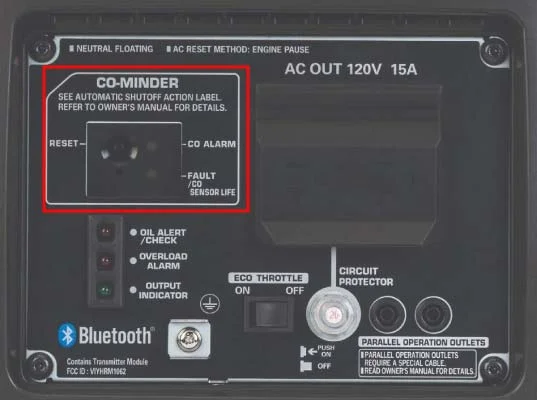How Can I Get Around the Generator’s CO Sensor? – [4-Step Guide]
Your generator’s carbon monoxide (CO) sensor may need to be inspected or temporarily bypassed if it continues to beep, abruptly turns off, or flashes a red light even when it is in a well ventilated area. Here is a discussion of the importance of the CO sensor, responsible treatment, and safe bypass procedures.
First, let’s examine the function of this sensor and its significance.
What Does a Generator’s CO Sensor Mean?
The majority of contemporary generators come equipped with a life-saving CO sensor, or carbon monoxide detector. Why? To notify you when your CO levels become dangerously elevated.
Why It’s Important:
The sensor whistles when CO levels rise. The generator may shut down on its own. Aids in avoiding carbon monoxide toxicity.
The CDC (Centers for Disease Control and Prevention) reports that CO exposure causes more than 430 deaths annually in the United States. As a result, generator makers are now compelled to incorporate CO sensors.
In closed spaces such as sheds, garages, or areas next to RVs, these sensors are quite important.
Why Must I Avoid the CO Sensor?
The CO sensor may occasionally become faulty and start to act strangely:
Unexpected generator shutdown; continuous beeping, even outside; Red light blinking in the absence of CO.
In these cases, it is easier to determine whether the CO sensor is the true problem by temporarily avoiding the sensor.
Important: If you intend to operate the generator indoors, avoid permanently blocking the sensor.
How to Get Around the Generator’s CO Sensor \[4 Simple Steps]
- Although circumventing the sensor is easy, it must be done with caution and only for diagnostic purposes.
- Let the Generator Cool Down
- Switch off the generator.
- Turn the Generator Back On
- Without the sensor, turn on the generator. The sensor is defective if it functions flawlessly without beeping or shutting off.
Replace the malfunctioning sensor in step four.
A new suitable CO sensor should be purchased.
Checklist for Safety Before Ignoring the CO Sensor
Be sure you adhere to these safety measures:
Keep hot or flammable objects away from the procedure; only do this in a well-ventilated area.
In certain states, operating without a CO sensor might result in heavy fines or penalties.
Do I Need a CO Sensor for My Generator?
Yes. Even if your generator does not include one, you should add one. Here’s why.

Prevents carbon monoxide poisoning
Is Carbon Monoxide Emitted by Whole House Generators?
Yes, without a doubt. As a byproduct of combustion, CO is released by all fuel-powered generators, whether they be standby or whole-house units.
Situations That Warrant a Temporary Bypass
| Problem | Cause | Should You Bypass? |
|---|---|---|
| Continuous beeping | Sensor malfunction | Yes, for testing |
| Instant shutdown | Sensor wiring issue | Yes, temporarily |
| No output | Generator fault or sensor conflict | Yes, for diagnosis |
For this reason:
They need to be placed away from windows and outside.
Appropriate plumbing and ventilation are essential. Leak prevention is ensured by routine maintenance.
In conclusion
On a generator, evading the CO sensor is a serious matter. It’s a diagnostic step rather than a long-term solution. The CO sensor may be malfunctioning if your generator randomly beeps or turns off. You may temporarily get around it by following the 4-step guide. Replace the sensor with a fresh one every time.
Tip: Call the generator’s support line or speak with a specialist if you’re not sure.
Use your generator judiciously, remain safe, and stay powered.
FAQs
How can I determine whether the CO sensor is malfunctioning?
The sensor may be damaged if the generator shuts off on its own, beeps continuously, or illuminates redly even in pure air.
Is it safe to turn off a generator’s CO sensor?
No, it’s not completely safe. To check for issues, you can do it for a short period, but only outside in the fresh air. Don’t ever use a generator inside without a functional CO sensor.
Will the CO sensor be important for my generator to function?
Yes, removing the CO sensor won’t stop most generators from operating. However, the lack of a functioning safety mechanism makes it risky. Don’t do this for too long.
Is it possible for me to change the CO sensor on my own?
Yes, if you follow the user manual and are familiar with basic tools. If not, get assistance from customer service or a repairman.
Where can I get a brand-new CO sensor?
It is available for purchase at hardware stores in your area or on Amazon, the generator’s official website.
